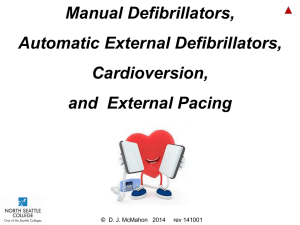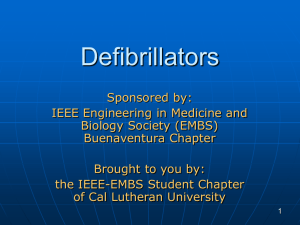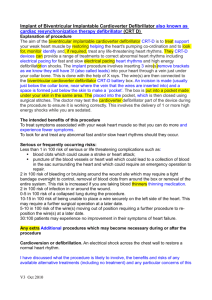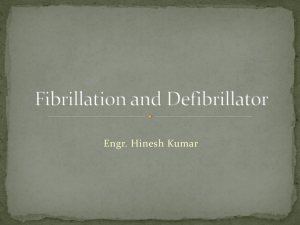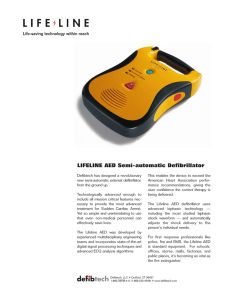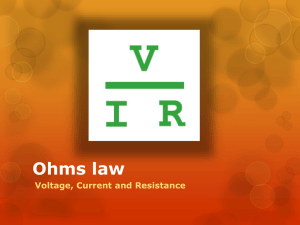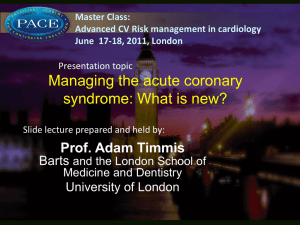Defibrillator
advertisement
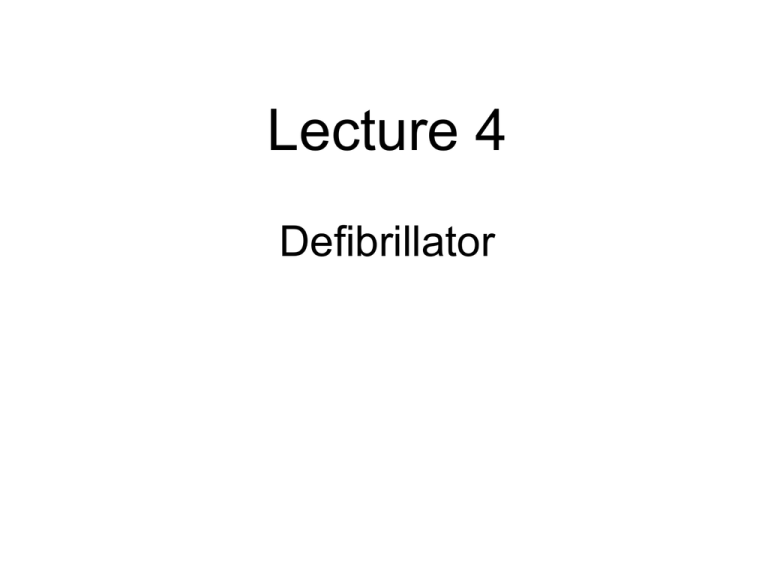
Lecture 4 Defibrillator Arrhythmias: SA Block P QRS T Defibrillators • The defibrillator is a device that delivers electric shock to the heart muscle undergoing a fatal arrhythmia. • Electric shock can be used to reestablish normal activity • Four basic types of Defibrillators – AC Defibrillator – DC Defibrillator Defibrillators • Before 1960 were AC model • This machine applied 5 to 6 A of 60 Hz across the patient’s chest for 250 to 1000 ms. • The success rate for AC defibrillator was rather low • Since 1960, several different dc defibrillators have been devised. • This machines store a dc charge that can be delivered to the patient. • The different between dc types in the wave shape of the charge delivered to the patient DC types • • • • 1- lown 2- monopulse 2- tapered (dc) delay 3- trapezoidal wave. Lown - The current will rise very rapidly to about 20 A under the influence of slightly less than 3 kV . - The waveform then decays back to zero within 5 ms and then produces a smaller negative pulse also about 5 ms. Lown wave form defibrillator • That is, the capacitor stores energy, WA, which develops a voltage, V, across its metal plates. – The amount of energy in units of joules is given by V2 WA C 2 • where C is the value of the capacitance measured in units of farads and V is the voltage across the capacitor. • The energy stored in the capacitor is proportional to the square of the voltage between its plates. – The amount of energy typically stored in the capacitor of a defibrillator, so that it can be later delivered to the patient, ranges from 50 to 400 joules. • All of this energy does not get into the patient. – Some is lost in the internal resistance of the defibrillator circuit, RD and some is wasted in the paddle—skin resistance, RE . • To calculate how much of this energy gets to the patient, resistance RT, consider the equivalent circuit. – The four resistors in this circuit are in series. • Therefore, the current in each of them is the same. – And the energy absorbed by any one resistor is proportional to the total available energy, according to the voltage division principle. • The formula for the energy absorbed by the thorax, WT is RT WT WD RD 2RE RT EXAMPLE • A defibrillator has an available energy, WA, of 200 joules (J). – If the thorax resistance is 40 ohms (W), the electrode—skin resistance of a paddle with sufficient electrode gel is 30 ohms and the internal resistance of the defibrillator is 10 ohms. • Calculate the energy delivered to the thorax of the patient. Solution • In this case, RT = 40 ohms, RE =30 ohms, and RD = 10 ohms. The equation for the amount energy delivered yields RT WT WD RD 2RE RT 40 WT 200 10 2 30 40 WT 72.7 Joules - Monopulse is a modified lown waveform and commonly found in certain portable defibrillator. - It is created by the same circuit of lown but without inductor L. - Tapered delay wave form , a lower amplitude 1.2 kV and longer duration 15 ms to a chive the energy level - It is created by placing two L–C sections - Trapeziodal low voltage / long duration ( 800 V : 500 V & 20 ms Defibrillator: Electrodes • Excellent contact with the body is essential – Serious burns can occur if proper contact is not maintained during discharge • Sufficient insulation is required – Prevents discharge into the physician • Three types are used: – Internal – used for direct cardiac stimulation – External – used for transthoracic stimulation – Disposable – used externally Defibrillator: Electrodes Cardioverters • Special defibrillator constructed to have synchronizing circuitry so that the output occurs immediately following an R wave – In patients with atrial arrhythmia, this prevents possible discharge during a T wave, which could cause ventricular fibrillation • The design is a combination of a cardiac monitor and a defibrillator Cardioscope ECG Electrodes Analog Switch Trigger Circuit Defibrillation Electrodes Defibrillator ECG AMP AND Gate 30ms Delay Threshold Detector Operator-controlled Switch Filter
